Everyday cars which are already starting to disappear
Discussion
s m said:
glazbagun said:
I pass a Puma on the way to work each morning, but can't help notice they're dying a death. The Cougar seems even rarer.
I think the Cougar was always a rarer model than the PumaThe Cougar wasn't much of a looker, it was always very awkward and ungainly from the side in particular, but they were fantastic to drive as a V6 manual. One of the best engine/induction notes I've heard too, all proper noise rather than tiresome and childish exhaust farts. That Duratec is one of the few really good V6 engines ever, as good as the Busso IMHO (but not as pretty).
bluezedd said:
I own a couple of them, but I feel like saab 9 3s will start to disappear given that they're not getting any newer. Their low value might also contribute as some repairs can cost more than the car is worth, especially when you combine multiple repairs.
Obviously it's inevitable that they'll die out, but they do seem to be holding out very well. I regularly see the late facelift models and they still look good, with none of the curling window rubbers and tired looking trim a lot of cars get, so in countries where used cars keep more value and there is more inclination to repair I can see them being around for a very long time. In the UK we'll scrap a perfectly good 12 year old car because it needs four tyres, discs and pads all round, and a suspension arm to pass an MOT.It does annoy me how some MOT requirements lead to a lot of cars just being scrapped before their time. It's especially daft when keeping an old car going as a run around for a few thousand miles a year has less environmental impact than trying to force folk into a newly manufactured car every 3 years.
On the Saab point. I quite fancied a late 93 estate but the GM association made me nervous and I read a few posts on here about there being some incredibly temperamental brain tied to the stereo which controls all sorts of things. If you can't fix it with a hammer and gaffer tape I'm out.
On the Saab point. I quite fancied a late 93 estate but the GM association made me nervous and I read a few posts on here about there being some incredibly temperamental brain tied to the stereo which controls all sorts of things. If you can't fix it with a hammer and gaffer tape I'm out.
Every day cars which are disappearing. I've noticed recently how relatively few Mondeos are left on the road. Considering how popular they were, there appears to be a dwindling number of Mk3s (2000-2007) and earlier models are extremely rare now. Even the Mk4s, which didn't sell in such big numbers seem quite rare these days, I'm assuming as most sold were diesel, its the usual DMF, turbo replacement issues which are sending them to the scrapper.
Similar thing with the popular VW Passat B5./B5.5 and B6. Don't see too many of these any more.
It does seem that 12-15 years is the cut off point for cars and after this time, numbers really dwindle.
Similar thing with the popular VW Passat B5./B5.5 and B6. Don't see too many of these any more.
It does seem that 12-15 years is the cut off point for cars and after this time, numbers really dwindle.
Every car I own, basically.
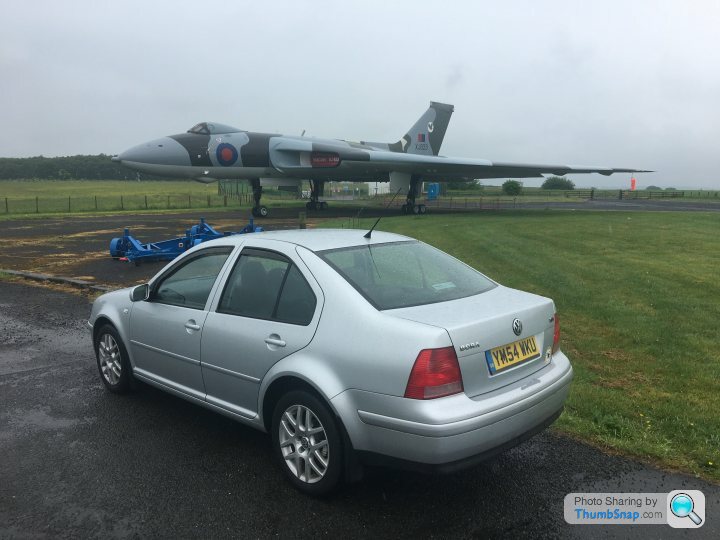
Bought my Bora in 2016, obviously when you buy a car you do tend to notice them everywhere. Saw a few each week. These days I see one or two a month. They've sat for the last 5 years or so in banger territory, where a decent failure will cost more than the car is worth. Mine is lucky that I bought it, the DMF and clutch failed which also destroyed the gearbox, anyone sane would've broken it for parts, it's a top spec Highline so it's value in parts exceeded the value of the car in it's broken state, but I got it fixed. They're also often driven by the kinds of people that drive around in them uninsured and get them seized and crushed. All a shame as they're really nice bits of kit for the money, nice interiors etc, and one of the quicker cars available for £500.
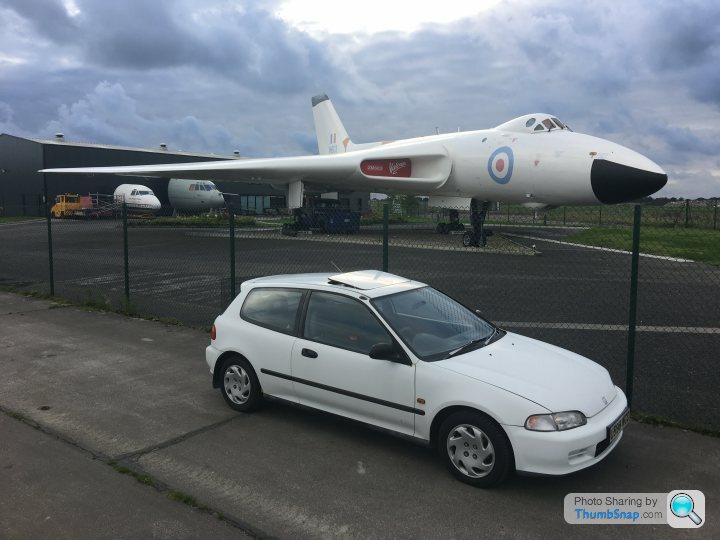
The humble EG and EK Civics. In fact this all applied to the 4 door MB posted a few pages ago too, they are all very closely related. These things are just beautifully engineered. Sadly they're a victim of their own toughness, meaning thousands have met their end on a banger track. Such a waste, great engines with performance that blows their period equivalents into the weeds, sweet handling with independent suspension even down to the 1.3 carb base model. The other thing that killed them was their tendency to rot, although they give plenty of warning, showing bubbling on the rear arches before any proper rot sets in. If the UK didn't use salt on the roads, these would still be rare due to the banger drivers but they wouldn't rot and mechanical failure would be basically zero. I don't remember EGs or EKs ever being a particularly regular sight, but I've not seen an EG on the road in several years, the last one I saw on the road was the one in the photo, which I immediately bought!
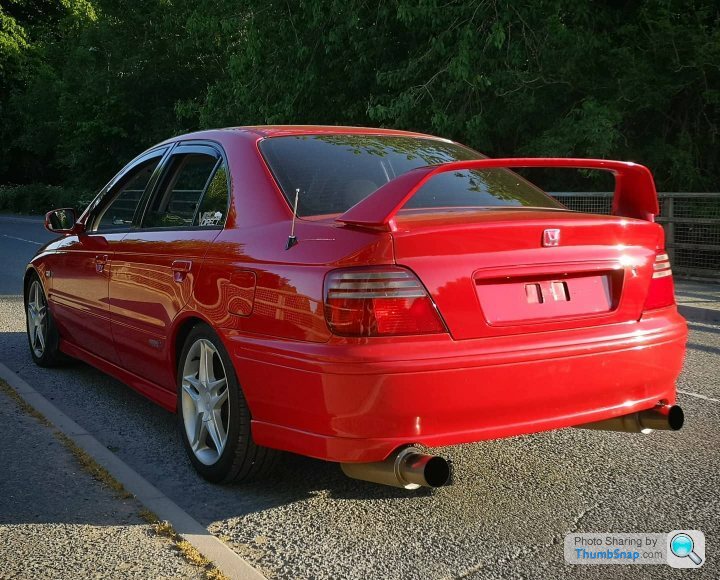
Not so much the Type-R, as they peaked at 1807 examples so were never common. There are 309 left on the road, so a survival rate of 17%. Not high, but not as low as its rivals I bet. The normal spec Accords of this gen were once everywhere, but now I only see a couple a month. This is likely down to the cats getting stolen and owners not knowing they can replace with an aftermarket one, so scrapping the car after finding out how much a cat will cost from Honda. They're worth over £400 as scrap, so loads of them get nicked. The cars are also great at rotting!
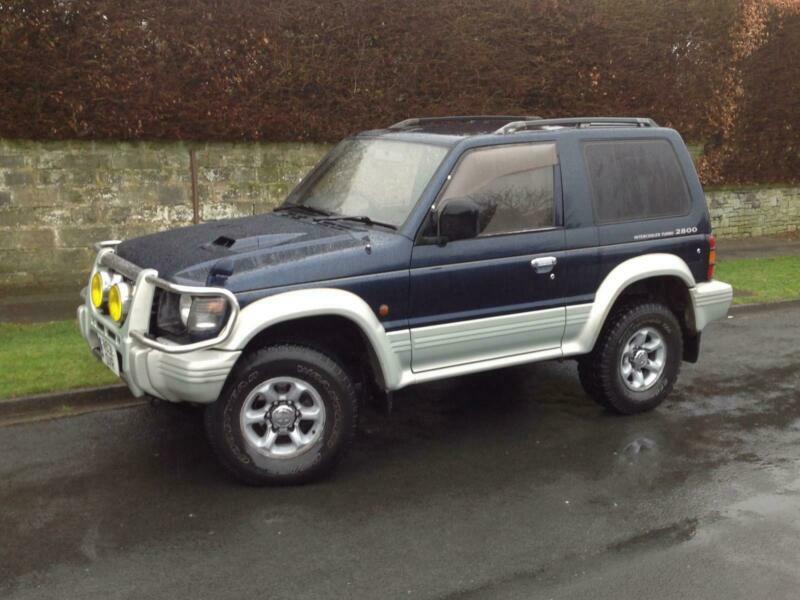
Dad had one of these from 2008-2010, back then we'd see a few a week, now pretty much never see them. Prone to rust and the engines can be troublesome. A lot go to Africa and Eastern Europe it seems. When Dad sold his (with blown HG, buyer aware) the buyer was in the process of buying a transporter full of Pajeros and sending them to Romania. He said that being a SWB, ours would likely be used for "hunting, fishing and offroad".

Bought my Bora in 2016, obviously when you buy a car you do tend to notice them everywhere. Saw a few each week. These days I see one or two a month. They've sat for the last 5 years or so in banger territory, where a decent failure will cost more than the car is worth. Mine is lucky that I bought it, the DMF and clutch failed which also destroyed the gearbox, anyone sane would've broken it for parts, it's a top spec Highline so it's value in parts exceeded the value of the car in it's broken state, but I got it fixed. They're also often driven by the kinds of people that drive around in them uninsured and get them seized and crushed. All a shame as they're really nice bits of kit for the money, nice interiors etc, and one of the quicker cars available for £500.

The humble EG and EK Civics. In fact this all applied to the 4 door MB posted a few pages ago too, they are all very closely related. These things are just beautifully engineered. Sadly they're a victim of their own toughness, meaning thousands have met their end on a banger track. Such a waste, great engines with performance that blows their period equivalents into the weeds, sweet handling with independent suspension even down to the 1.3 carb base model. The other thing that killed them was their tendency to rot, although they give plenty of warning, showing bubbling on the rear arches before any proper rot sets in. If the UK didn't use salt on the roads, these would still be rare due to the banger drivers but they wouldn't rot and mechanical failure would be basically zero. I don't remember EGs or EKs ever being a particularly regular sight, but I've not seen an EG on the road in several years, the last one I saw on the road was the one in the photo, which I immediately bought!

Not so much the Type-R, as they peaked at 1807 examples so were never common. There are 309 left on the road, so a survival rate of 17%. Not high, but not as low as its rivals I bet. The normal spec Accords of this gen were once everywhere, but now I only see a couple a month. This is likely down to the cats getting stolen and owners not knowing they can replace with an aftermarket one, so scrapping the car after finding out how much a cat will cost from Honda. They're worth over £400 as scrap, so loads of them get nicked. The cars are also great at rotting!
Dad had one of these from 2008-2010, back then we'd see a few a week, now pretty much never see them. Prone to rust and the engines can be troublesome. A lot go to Africa and Eastern Europe it seems. When Dad sold his (with blown HG, buyer aware) the buyer was in the process of buying a transporter full of Pajeros and sending them to Romania. He said that being a SWB, ours would likely be used for "hunting, fishing and offroad".
Jaaack said:
Every car I own, basically.

Bought my Bora in 2016, obviously when you buy a car you do tend to notice them everywhere. Saw a few each week. These days I see one or two a month. They've sat for the last 5 years or so in banger territory, where a decent failure will cost more than the car is worth. Mine is lucky that I bought it, the DMF and clutch failed which also destroyed the gearbox, anyone sane would've broken it for parts, it's a top spec Highline so it's value in parts exceeded the value of the car in it's broken state, but I got it fixed. They're also often driven by the kinds of people that drive around in them uninsured and get them seized and crushed. All a shame as they're really nice bits of kit for the money, nice interiors etc, and one of the quicker cars available for £500.

.
I didn’t even read any of what you wrote. I’m just looking at the greatest bomber we ever had. 
Bought my Bora in 2016, obviously when you buy a car you do tend to notice them everywhere. Saw a few each week. These days I see one or two a month. They've sat for the last 5 years or so in banger territory, where a decent failure will cost more than the car is worth. Mine is lucky that I bought it, the DMF and clutch failed which also destroyed the gearbox, anyone sane would've broken it for parts, it's a top spec Highline so it's value in parts exceeded the value of the car in it's broken state, but I got it fixed. They're also often driven by the kinds of people that drive around in them uninsured and get them seized and crushed. All a shame as they're really nice bits of kit for the money, nice interiors etc, and one of the quicker cars available for £500.

.
Amazing aircraft.
All my cars are rare sights today but I like their quirks. Pretty cool I think and I keep on top of mainteance so they're pretty cheap to run. Yeah I could have a couple lease cars on tick but they'd bore for being too perfect and numb.
'88 Mk2 Golf GTI
'94 Corrado 16v
'95 Corrado VR6
'02 Golf GTTDI
'13 Exeo ST
Might change the Corrado 16v for something else but can't think what.
'88 Mk2 Golf GTI
'94 Corrado 16v
'95 Corrado VR6
'02 Golf GTTDI
'13 Exeo ST
Might change the Corrado 16v for something else but can't think what.
Edited by _Mja_ on Friday 18th September 21:35
I must say the early Insignias seem to be thinning out quite alarmingly in recent years.
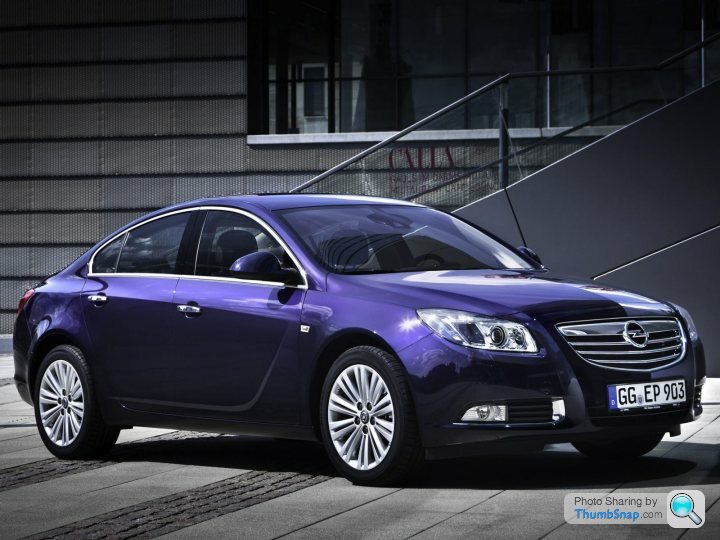
As a car lover drawn into classic car enthusiasm by bland turn-of-the-millenium styling, this was the first ordinary new car I looked at and thought "That actually looks really good, and not just for a modern car" I clearly remember loving all the chrome trim and the fastback styling.
It's a shame so many were ordered in grey on grey office-drone spec, the other day I saw a top of the line V6 one in a sort of dark purple with a cream wood'n'leather interior and it looked gorgeous.

As a car lover drawn into classic car enthusiasm by bland turn-of-the-millenium styling, this was the first ordinary new car I looked at and thought "That actually looks really good, and not just for a modern car" I clearly remember loving all the chrome trim and the fastback styling.
It's a shame so many were ordered in grey on grey office-drone spec, the other day I saw a top of the line V6 one in a sort of dark purple with a cream wood'n'leather interior and it looked gorgeous.
Jimmy Recard said:
Morningside said:
Not many were a limited edition. 'Limited' and 'Limited SE' were trim spec - like Ghia or GL or whatever.Car_Nut said:
LARGE PEOPLE CARRIERS
In the absence of any suggestions, this time I have decided to leave the realms of anything that is remotely interesting to most of us on this website, and to move into the realm of consumer advice on domestic appliances. I must warn you that my knowledge of people carriers is distinctly limited, as the subject reduces me to a somnolent state. (I hired a new Zafira Tourer for a few days in Ireland with the family last summer, honestly, I can remember nothing about the driving experience whatsoever, apart from the irritating rattle of its diesel engine: it was a vehicle where every vestige of character had been ruthlessly extirpated). As ever, I will correct any factual errors, if you shout.
I have decided to adopt a fairly comprehensive approach, and to stick in just about everything that I can think of in the large people carrier segment. I will be covering their smaller brethren separately, later. I have included both bespoke people carriers and van-based models, although we need to recognise that there is some overlap with the minibus and motor caravan segments in the latter (but I have, for example, excluded anything listed as a Ford Transit Minibus, or a VW caravan).
I accept that there can be no hard and fast definition of “large” and “small” people carriers, not least because the relative size of particular models has not been constant across generations, for example, the other day I saw a 58 plate Zafira parked alongside a 60 plate Touran, and they were the same size. As ever, this is something of a personal classification.
The fourteen models considered in this analysis are as follows (note, as in the other posts, the dates ranges refer to those over which the model was registered new in the UK):
Citroën Synergie/C8/C4 Grand Picasso: Synergie to 2002, C8 2003 to 2009 (plus 71 units in 2010), C4 Grand Picasso First Generation 2008 to 2013, Second Generation 2013 on.
Chrysler Voyager/Grand Voyager: Fourth Generation to 2008, Fifth Generation 2008 to 2014
Fiat Ulysse: First Generation to 2002, Second Generation 2003 to 2005.
Ford Galaxy: Mk 1 to 2006, Mk 2 2006 to 2015, Mk 3 2015 on.
Ford Tourneo Custom/Transit Tourneo: Mk 4 Transit-based to 2012, Mk 5 Transit-based 2013 on.
Kia Sedona: First Generation to 2006, Second Generation 2006 to 2014.
Mercedes Viano/V Class: W638 to 2003, W639 2004 to 2015, W447 2015 on
Peugeot 806/807: Peugeot 806 to 2002 (plus 19 units in 2003), Peugeot 807 2002 (61 units only registered in 2002) to 2010.
Renault Espace/Grand Espace: Espace III to 2002, Espace IV 2003 to 2012.
Seat Alhambra: Mk 1 to 2010, Mk 2 2010 on.
Toyota Previa: Second Generation to 2006.
Vauxhall Zafira: Zafira A to 2005, Zafira B 2005 to 2014 (plus 153 registered in 2015), Zafira Tourer C 2011 on.
Volkswagen Caravelle: Transporter T4 based to 2003, Transport T5 based 2003 on.
Volkswagen Sharan: Mk 1 to 2010, Mk 2 2010 on.
Given that graphs with more than eight lines become difficult to read, the initial graphical analysis splits the cars into two groups: the two groups of three that had shared platforms built in a single factory, for at least one generation (Galaxy/Alhambra/Sharan, and the Citroen/Fiat/Peugeot “Eurovan”) and those with unique platforms, including the three models most obviously based on van platforms (Tourneo/Mercedes/Caravelle), yes, I am aware that the Eurovan was also based on commercial underpinnings. The enhanced tendency to platform share between manufacturers is a particular feature of this market segment.
There are two particularly interesting things to look for when we start to compare the survival rates: do all sisters have similar survival rates, and do bespoke or van-based people movers survive better?
I have had a particular difficulty with the Tourneo data, in which there were numerous glitches picked up by my sense checks: in studying the DfT data, across several classes of car, it has become increasingly clear that there are considerable discrepancies between the rigor with which data from different manufacturers are recorded. Ford dealers are particularly sloppy in the way that they record registration data, which is then mirrored in the DfT database. This contrasts with, say, Peugeot, whose data is a model of clear and reasonably consistently recording, accordingly, the issue evidently originated from the top. Only for the past two years has the Tourneo data been clearly recorded. The following are all ways that Transit based Tourneos seem to be recorded: Ford Tourneo 280 SWB, Ford Tourneo Custom, Ford Transit Tourneo, Ford Transit 280 Tourneo, Ford 140 T280 Trend Tour, and these are also spread through the “Car”, “LGV”, “Bus”, “Other” and “HGV”(!!) datasets, for example, almost every mid noughties example were recorded as buses on first registration: it took some time to work out why there were only ten registrations and 484 survivors in one year! There may be others that I have missed, but quite frankly spending the best part of three hours of my private time sorting this model out was quite enough. Once I obtained sufficient data for this model to obtain an indicative picture I stopped. In any case I suspect that some vehicles are recorded in an indistinguishable manner from their Transit brethren. People with nasty suspicious minds, like me, might suspect that manufacturer incentives to dealers have an obfuscating role.
Similar dataset inconsistencies afflict the Volkswagen Caravelle as well, although to nothing like the same extent, again I have trawled through every dataset to pick everything up that I could. The issue that I have with the Caravelle data is that I suspect that there are quite a few motor caravan conversions lurking beneath the surface. I believe that that it is reasonable to hypothesize that caravan conversions tend to outlive the normal run of vehicles on which they are based by a considerable margin, certainly this is my perception. Accordingly, I suggest that the survival rate for the Caravelle in people carrier configuration is likely to be overstated. There is also some evidence for “hidden motor caravans” when one examines the DfT data in detail: for fairly new cars, it is not unusual to see the odd SORNed vehicle; however, in the case of the Caravelle there are large numbers of, recently registered, specific variants that are SORNed, take for example the SE TDI 180 Auto, we have 52 No. SORNed 2013 units, 91 No. 2012 units, and 19 No. 2011 units, or in the case of the SE BMT TDI A we have 46 No. 2014 units, and 54 No, 2013 units. Given, that, roundly, we are talking 1,000 units pa registered across all variants these are pretty staggering numbers, I suggest that these are likely to be commercial camper van rentals laid up for the winter.
To prove that it can be done right, if the manufacturers/distributers can be bothered to keep their dealers in line, the Mercedes Viano/V Class results came out beautifully first time. Accordingly, I have not bothered to examine anything other than the “Car” dataset for this model.
The DfT states that its research indicates that approximately 2% of the entries in the database has one parameter recorded incorrectly. I would suggest that these errors are not spread evenly between all models.
OK lets’ look at first registrations in the shared platform category:
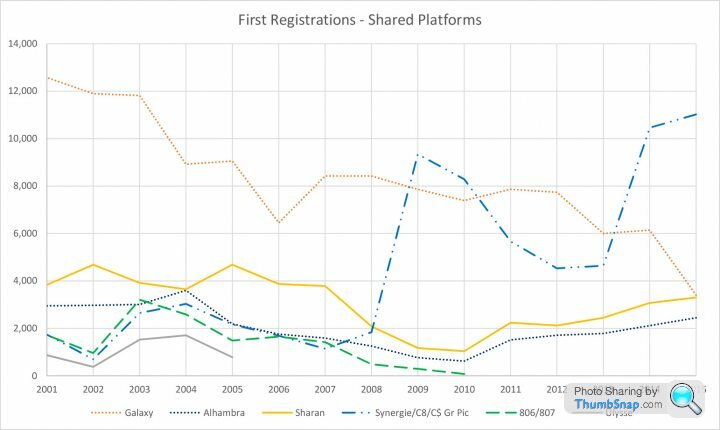
Moving onto the unique platform category:
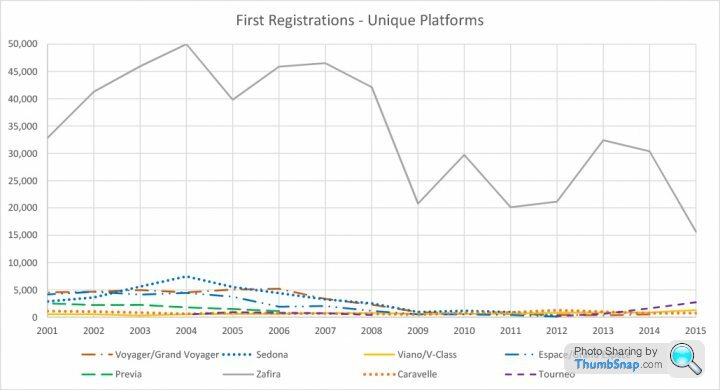
Unfortunately, the Zafira’s sales are so great (relatively) that it swamps everything else, so if we reproduce this at the same scale as the first graph, with the Zafira off the top of the graph:
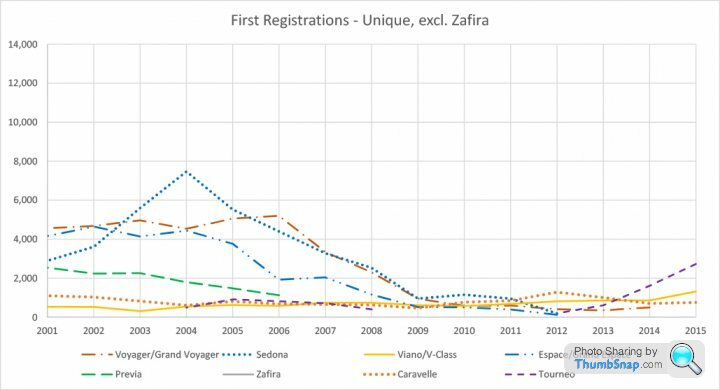
As we are analysing just about the entire market segment, we can therefore make a reasonable stab at the total registrations in it:
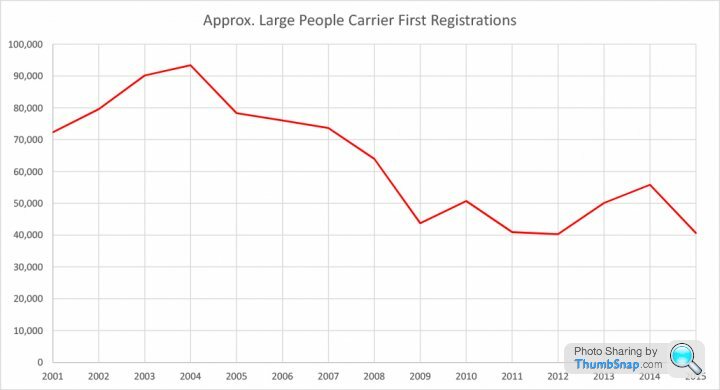
We can see that, on our analysis, large people carrier registrations dropped by 43.8% overall between 2001 and 2015. The segment peaked in 2004 at 93,372 units, before sales declined to progressively to 2009, since which time sales have fluctuated between 40,000 and 55,000 units. 2015 represented a sales low point, some 56.5% below 2004 levels, partial examination of data for the first nine months of 2016 suggests that 2015 might be the commencement of a further downward movement in volumes for the market segment. One could postulate that this results from buyers moving on to SUVs at one end of the market, and the greater choice of smaller people carriers at the other end of the market, some of which are growing in size. Indeed, I understand that the new Renault Grand Espace is positioned in the SUV sector.
This thread has been concerned with models that are disappearing from our roads, this analysis establishes that large people movers are an entire class of vehicles that are in decline on our roads. While I am not suggesting that they will disappear in the foreseeable future, as they have a unique niche, they are certainly becoming less ubiquitous.
This market segment has seen some of the most Darwinian outcomes, with the dominant models squeezing their competitors out of a shrunken market. Models leaving the marketplace include the Fiat Ulysse (2005), Toyota Previa (2006), Peugeot 807 (2010), Kia Sedona (2012), the Renault Grand Espace (2012), and the Chrysler Grand Voyager (2014). In many of these cases, the models are still manufactured, but no longer imported into the UK. The trends that we can observe suggest that other models are likely to follow: those in the weakest position are clear. The large people carriers that remain on our roads seem set to become increasingly less heterogeneous. The next graph shows the market shares that would be deduced from our numbers for all models that ever exceeded an 8% market share:
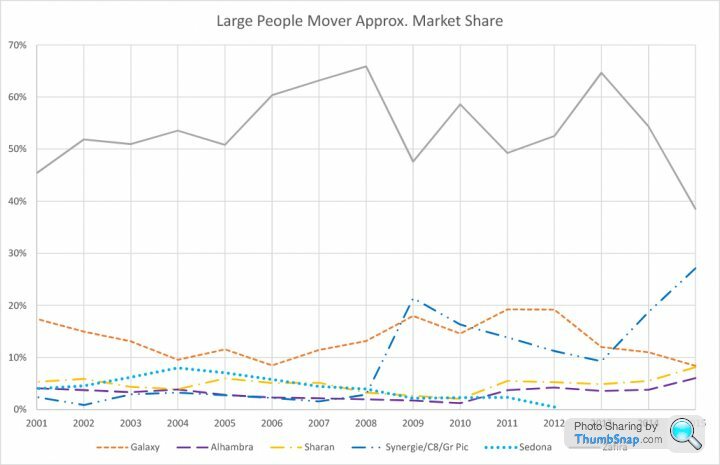
The survival rate graphs for the two groups of vehicles are as follows:
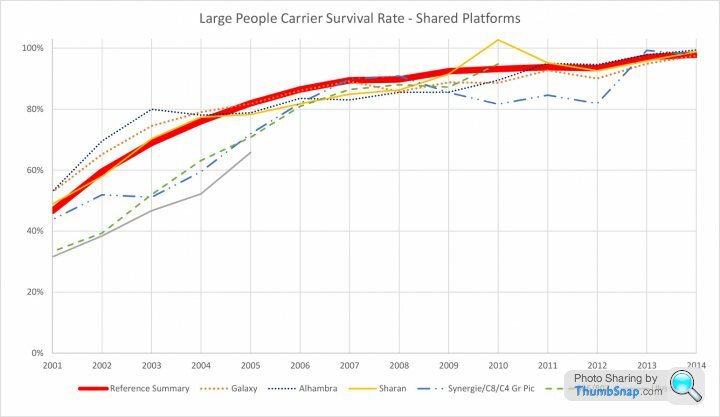
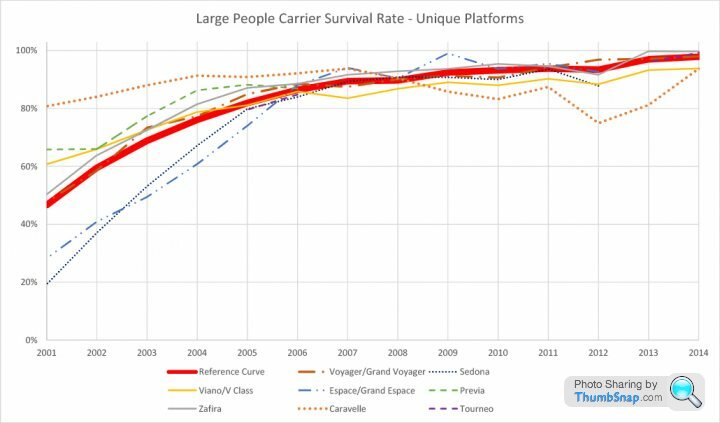
As discussed above, the rather erratic performance of the VW Caravelle is probably due to inconsistency in the category of vehicle that these are registered as.
As ever, the 2001 to 2009 portion of the survival curves is the most interesting part:
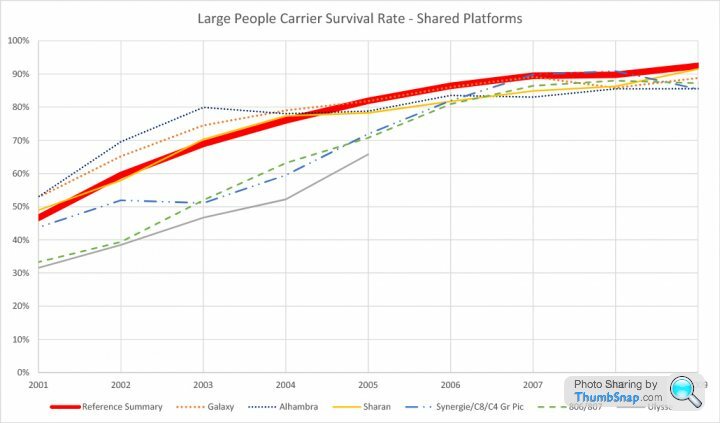
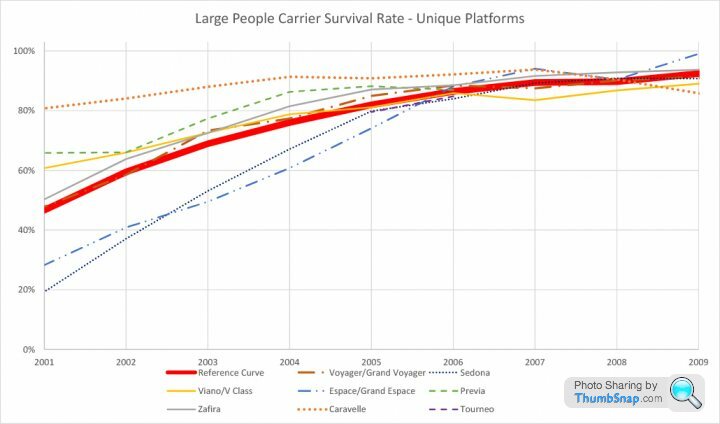
In my previous posts, I have highlighted the issue of fitting registration data, which is only available by year of first registration, against details of surviving vehicles for which I have used the year of first manufacture datasets. Datasets for taxed and SORNed vehicles by year of first registration are also published by the DfT, which would avoid the difficulties that I previously highlighted. However, I have tended to eschew this data because of the issue post-registration of imported vehicles, in an attempt to keep the results rooted in the age of the vehicles as far as is possible. This has been nagging at me a bit, I have therefore carried out a sensitivity test using the alternative data. The resulting curves were pretty indistinguishable really, other than where only tiny numbers of vehicles are registered, for which in any case I tend to suppress the results, to confine the analysis to statistically significant sample sizes. Accordingly, I will be carrying on with my established practices.
As we have a fairly comprehensive analysis of this class of vehicles we can also produce an overall survival rate curve for large people movers, as follows:
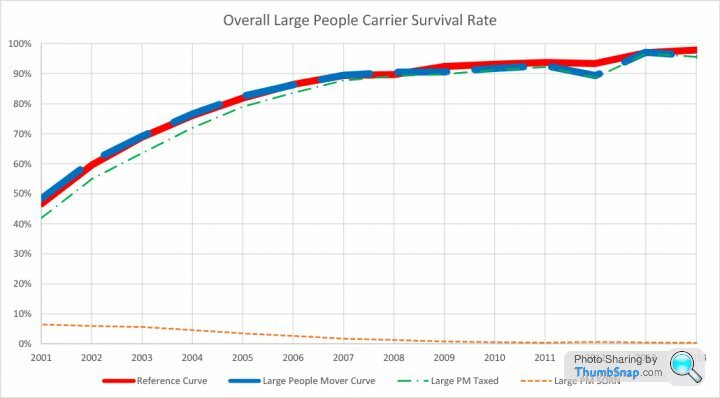
I must say that this surprises me somewhat: given the utility of these vehicles, particularly to those with an excess of children/grannies/large dogs/wardrobes/five-a-side football teams/love for Ikea, I was anticipating a survival rate somewhat above the standard reference curve, not one that is closely pinned to, and indeed mainly below, it. As we have already found that estates survive noticeably better than the saloons and hatchbacks on which they are based, clearly for reasons of utility, this cannot be because of a lack of desire to keep the vehicles on the road, it can only be because they become too difficult/expensive to keep on the road as they descend into the banger market.
Notwithstanding this, we can see that there is clear dichotomy between a group with above average survival rates, and one with pretty dreadful survival rates, with little middle ground between them. One could advance the theory that the overall survival rate for the group is dragged down below its natural group by a subset with exceptionally poor survival characteristics, almost all of which have now departed the market. I would therefore suggest that that the mean survival rate curve for the group can be expected to improve in comparison to the standard reference curve in the future.
I would not too excited about the rather wobbly overall survival rate curve post-2006, I believe that this is simply because I have not sought to investigate inconsistent vehicle classification in the databases in more recent years, to the same extent that I have in the, more interesting to us, earlier years.
We can draw the following conclusions about the performance of individual models:
Citroën Synergie/C8/C4 Grand Picasso: the introduction of the C8 results in an absolute decline in survival rate of around 9%, or to put it another way a twelve-year-old C8 (51.1% survival rate) is about 18% less likely to have survived than was the case for a Synergie. The difference is so great that a 2001 Synergie has a higher survival rate than a 2002 C8! This differential increases when one considers taxed vehicles (43.8% v 42.1%). The ‘death curve’ for C8s appears to commence at eight years old, but it is closely aligned with its Peugeot and Fiat sisters. The survival rate for the Synergie is more than 10% better than its Eurovan sisters, but on the same trend line. It is, however, below the reference curve, although closing to within 3.4% of it for 2001 cars. The curiosity is why of all of both generations of Eurovan is the Synergie alone out of line with the others? From 2009 onwards the form of the survival curve is lost: I have not explored the reasons for this, as I am less interested in this part of the curve, but I strongly suspect that this results from the same issue of vehicle misclassification discussed above for the Tourneo and the Caravelle. Suffice to say that I believe that the survival rates of late C8s and early C4 Grand Picassos are likely to be well above the value shown for 2009 to 2012 cars. The survival rate of 2001 Synergies at the end of 2015 was 43.8%.
Chrysler Voyager/Grand Voyager: generally, this model has a survival rate that is closely pinned to the standard reference curve. There are early signs that there might be a downward dip in survival rates with the transition to the Fifth Generation, but another couple of years’ worth of data will be required to confirm this. The ‘death curve’ commences for ten-year-old cars, and steepens rapidly after twelve years: the figures for 2003 to 2001 cars being 73.3%, 58.5% and 47.8% respectively. The Fourth Generation Voyager and Grand Voyager do not appear to be imminent danger of disappearing from our roads, but their ranks are progressively thinning out. My perception is that these seem much rarer on our roads than they were a decade ago. The survival rate of 2001 Voyagers and Grand Voyagers at the end of 2015 was 47.8%.
Fiat Ulysse: there appears to be a fairly consistent transition in survival rates between the First and Second Generations. There is however, an unexpected dip in the survival rate for 2004 cars, which is 4% below what one would expect from the curve trend. Given that the sample size is reasonable (1,705 recorded as being registered in the year), there is no obvious explanation for this, but it might be that, again, some vehicles are recorded in the wrong database. The survival rate is not good, being the lowest of the Eurovans, running between 15% and 24% (absolute) below the reference curve, but it is, at least, a fairly progressive rate of decline, with no sudden ‘death curve’. If this trend continues, it is even possible that the oldest examples will have a survival rate above the reference curve at an age of around seventeen to eighteen years. Given that the three Eurovan sisters were built in the same factory with identical mechanicals one is left to ponder why, consistently, the Fiat Ulysse has the worst survival rate. In essence, there are three possible explanations: (i) possibly the engine mix distribution differs between the three manufacturers (not examined); (ii) there is less enthusiasm to keep Fiat badged versions going; or (iii) Fiat’s spare parts supply and/or dealer support is worse. The survival rate of 2001 Ulysses at the end of 2015 was 31.6%.
Ford Galaxy: the Galaxy’s survival rate is closely matched to that of its two sisters, all of whom have similar survival rate curves, in general it is ‘nip and tuck with the Seat Alhambra’s and a little better than the VW Sharan’s. In comparing these three siblings it should be noted that the level of mechanical homogeneity is not as great as the Eurovans, and that this tended to diverge over time as the Galaxy switched over to Ford engines in lieu of VW ones across the range. There is no discernible difference between Mk 1 and Mk 2 survival rate at the transition, yet, although it is possible that one will emerge as the cars age further. The survival rate of all three of these vehicles at December 2015 was below the standard reference rate, until they reached eleven years of age, at which point they began to enjoy above average survival rates. In the case of the Galaxy, the ‘death curve’ commenced at a vehicle age of eleven years, but was more gentle than the standard reference curve for the first couple of years, before closely following its form, but around 5.5% (absolute) above it. The survival rate of 2001 Galaxys at the end of 2015 was 52.8%.
Ford Tourneo Custom/Transit Tourneo: as discussed above, I have had considerable difficulty piecing together a survival rate curve for this model, and the partial one presented, covering the 2005-6 and 2013-14 periods, should be treated tentatively. I was particularly keen to include this model as at both of the tiny village schools that our children have attended a parent has had one of these. Indeed, this was the only people carrier at each school, thus in my personal experience this is the most popular people carrier that there is! (The serious side to this is that this illustrates the danger of relying on one’s personal experiences, rather than using a statistically significant sample). The indications that we have are that Transit-based Tourneos have a survival rate that is close to but slightly below that of the Galaxy (1.3% to 2.3% in 2005-6), but this is stated with a low degree of confidence.
Kia Sedona: the introduction of Second Generation cars appears to result in a decline of approximately 2% in the survival rate. This is not good news as the survival rate curve of the First Generation is pretty disastrous beyond cars’ tenth birthdays: not so much of a “death curve” but more of a screaming dive to oblivion (for example the difference in survival rate between 2001 and 2002 cars equates to 48.0% of the surviving stock in 2002: a thirteen-year-old Sedona had only a one in two chance of becoming a fourteen-year-old one in 2015). The survival rate of 2001 Sedonas was just 19.3%, and only 12.5% of 2001 Sedonas were still taxed, as at 31 December 2015. These figures are comparable to the Daewoo Lanos (18.3% and 14.9%), which were the worst analysed to date: a shockingly poor performance. However, despite the discouraging early signs, we do not know that the “death curve” of Second Generation cars will be quite as drastic as the earlier cars. There are a couple of First Generation examples for sale on a well-known car sales website at present with no MoTs, whose MoT history makes interesting reading. Without doubt, this is a model that certainly fits the theme of the thread: a few years ago, these were part of the everyday road landscape, whereas now they are disappearing at a colossal rate. So, anyone who wishes to form a collection of everyday cars of the 2000s needs to add a Sedona to it now (and get to work with wire brushes, Hammerite/Bondaprimer, underseal and Waxoil under the car). Otherwise, in my view, this is a model to be avoided like the plague beyond their tenth birthdays, unless so cheap that the value of the motoring in the remaining period to the next MoT exceeds the price of the car. If you already own one get rustproofing under the car now.
Mercedes Viano/V Class: given the issues that afflict the Tourneo and Caravelle data, there is reason to suspect that the V Class and Viano data is not entirely clean, despite the evidently better efforts of Mercedes dealers than their colleagues at Ford and VW. Accordingly, we need to treat the, apparently, below average survival rates of post-2006 Vianos with some caution, although that for pre-2006 V Classes and Vianos is a lot clearer. The transition between the W638 and the W639 is totally seamless in survival rate terms. Pre-2006 the survival rate is above the reference curve, and to an increasing extent as time passes. Achieving an absolute advantage of some 14% for 2001 registrations. Neither the W638 nor the W639 have yet entered a steep ‘death curve’, instead numbers are progressively reducing at a rate that averages almost exactly 5% (absolute) per annum. Its survival rate appears to be above that of the Tourneo, but below that of the Caravelle; instinctively this feels right to me, given the number of rusty Mercedes Vitos and Ford Transits, of no great age, one sees, which appear to me to exceed the number of rusty VW Transporters. The survival rate of 2001 V Classes at the end of 2015 was 60.7%.
Peugeot 806/807: I am reluctant to call any difference in the survival rate between the 806 and the 807 without a little more data: if one crunches the numbers on the 2002 data 806s have a 38.5% survival rate and 807s a 52.5% survival rate, but are slightly more likely to be SORNed rather than taxed. However, the sample size of 61 No. 807s registered in 2002 is too small to be statistically reliable, furthermore the fit of the survival curve is not altogether clear in 2002-3. The Peugeot 806 survives slightly better (1% absolute) than Fiat Ulysse, but over 10% worse than the Citroen Synergie. On the other hand, the Peugeot 807, just, achieves the best survival performance for any of the Eurovan people carriers. In either incarnation, the Peugeot’s survival rate (like the remainder of the Eurovan group) was well adrift of both the reference curve and the people carrier mean survival rate after vehicles exceeded eight years of age, the point at which the ‘death curve’ commenced. The survival rate of 2001 806s at the end of 2015 was 33.3%.
Renault Espace/Grand Espace: I find it sad that a car that was as trend-setting as the original Renault Espace is now all but extinct in the UK. Despite my general disinterest in people carriers as a type, if there is one car that I could go back a few years, and, cheaply, save another example for posterity it would be this. But this survey starts another couple of generations down the line, and only captures the end of the Espace/Grand Espace III at that. The Espace III is a model that is heading for oblivion rapidly, with the number of survivors diving almost as rapidly as those of the Kia Sedona. However, this is the good news as the Espace/Grand Espace IV has an even worse survival rate, which is not only 3.5% worse than that of the Espace III, but is also worse than that of Kia Sedonas of equivalent age, albeit on a slightly less severe rate of decline. It is touch and go whether the Espace IV will manage to get above the Sedona before both become extinct. The only saving grace for either in the battle for the wooden spoon is that on the 2003 snapshot that we took, it looks as is the Kia Carens might actually be worse, but we will get to that model in due course… The survival rate of the Espace IV appears entirely normal until 2006 cars (nine years old at the time of the survey), whereafter, the survival rate goes into freefall, dropping at absolute rates of 14.0%, 13.3% and 11.4%, over the preceding three years, which equates to 15.9%, 17.9%, and 18.7% respectively of the surviving stock in each year. Accordingly, Espace IVs are heading towards extinction at an accelerating rate. The $64k question, is are post-2006 Espaces more durable, or is that, as their value declines people start give up on a struggle to keep them roadworthy after their ninth birthdays? The 2016 data should tell us, when it is released in April. The survival rate of 2001 Espaces and Grand Espaces at the end of 2015 was 28.3%.
Seat Alhambra: as discussed above, the Alhambra’s survival rate curve is closely matched to that of its two siblings, which as at the end of 2015 exceeded the reference survival rate after cars passed their eleventh birthdays. Although it is a little early to be certain, it appears that the survival rate of the Mk 2 Alhambra is around 5% better than that of the Mk 1, at the generation change. A slightly curious feature is that the survival rate of 2003 to 2005 cars was almost identical at the end of 2015, indeed the survival rate of 2003 cars was slightly above that of 2004 and 2005 cars (79.9%, 78.0% and 78.8% respectively). My first thought was that the slight increase in the survival rate of older cars might be as a result of a change from petrol to diesel engines and a differential in the survival rate between them. However, not only is the proportion of petrol engines small for all of these years (declining from 7.9% of Alhambra registrations in 2003 to 2.8% in 2005), but that the same characteristics occur for both petrol and diesel variants, except that a peak in the survival rate occurs in 2004 not 2003 for petrol models. It is therefore hard to escape the conclusion that the inherent survivability of the Mk 1 Alhambra declined for post-2004 cars. I do not believe that we can ascribe this to the perceived decline in VW Group quality from the mid-2000s onwards that we have noted before, as neither of its sisters exhibit the same characteristics; so, this is all a bit of a mystery to me – ideas anyone? The ‘death curve’ for this model commenced after twelve years, and is fairly drastic thereafter, although the survival rate is still above the reference curve at the commencement of useable records in 2001. The survival rate of 2001 Alhambras at the end of 2015 was 53.0%.
Toyota Previa: the single generation of the Previa that was sold within the timeframe of the information included in the DfT’s data had an above average survival rate, and indeed was the top-surviving purpose designed large people carrier. The fact that the Third Generation Previa has never been officially imported into the UK does not permit investigation of the trait of declining survival rates for mid-2000s introductions noted for other Toyota models analysed. The survival rate of 2001 Previas at the end of 2015 was 65.8%.
Vauxhall Zafira: there is no detectable change in survival rate and the transition between the Zafira A and the Zafira B. Otherwise, the survival trend is much the same as all the other GM models examined: average. Its survival rate curve is close to the reference curve, being slightly (3% to 5% absolute) above it. The ‘death curve’ for the Zafira steepens appreciably as the model ages, so that as at the end of 2015 a 2002 Zafira had a 21.2% probability of dying that year. The survival rate of 2001 Zafiras at the end of 2015 was 50.3%.
Volkswagen Caravelle: little difference in survival rates can be seen at the transition between the T4 and the T5 generation, yet. The Caravelle had the highest survival rate of any vehicle examined in the large people carrier class, probably assisted by the strong residual values that this model attracts, making expensive repairs worthwhile, and I consider that it is definitely assisted by the number of motor caravan conversions, which as noted, can be expected to increase vehicle longevity. The headline survival rate of the T4 Caravelle is well up with the R50/R53 Mini and the X350 Jaguar XJ; however, for those that are used purely in the people carrier roll the headline figures probably overstate the true survival rate, as a result of the inclusion of motor caravan conversions. But even if one knocks a few points off the headline survival rate the Caravelle would still top the large people carrier survival stakes by a comfortable margin. As at the end of 2015, it appears that numbers only declined through natural wastage to a vehicle age of eleven years, thereafter the rate of decline increased, but only to the rate of approximately 4% of the surviving stock per annum. It is therefore clear, in the context of the thread that T4 and T5 based Caravelles are likely to be with us for many years yet. The survival rate of 2001 Caravelles at the end of 2015 was 80.8%.
Volkswagen Sharan: much the same comments apply to the Sharan as to the Galaxy and the Alhambra, it does however, have a survival rate that is consistently worse than its siblings; a disappointing result for what is supposed to be the premium version of the range. The ‘death curve’ for Sharans commenced after eleven years in 2015, and thereafter closely followed the reference curve. The survival rate of 2001 Sharans at the end of 2015 was 48.9%.
Finally, to return to the two questions that we asked above, the answers to which were yes and maybe. As can be seen in the graphs above, the survival rate curves of the Galaxy/Alhambra/Sharan and the Eurovan groups of vehicles are internally consistent, in that all conform to similar trends and have fairly small spreads. There are a few inconsistencies, but these are of a fairly second order nature; however, in each group not all marques have identical survival rates: fairly consistently, one survives better than its siblings, and one marque worse. The reasons for this are not immediately apparent to me. We only have to intra marque comparisons between van-based and purpose designed people carriers, between the Ford Galaxy and Transit Tourneos, and between VW Caravelles and Sharans. The survival rate of the Tourneo was slightly below that of the Galaxy, but the results for the Tourneo are so incomplete and subject to question, I am disinclined to place much credence on this finding, particularly given eth small difference. In the case of the VW twins, it is clear that the Caravelle enjoys a substantial advantage over the Sharan, and one that grows with age. However, I do not think that having solid results for just one marque pair is sufficient to draw a firm conclusion.
As ever, I would be grateful for any feedback or comments that you have, and am very happy to have a discussion about any issue that emerges.
I am thinking of doing something more PH worthy, and move onto junior executive cars next. I would be pleased to accept nominations for inclusion, beyond the obvious trio.
F@ck me! Did you get a PhD for that?In the absence of any suggestions, this time I have decided to leave the realms of anything that is remotely interesting to most of us on this website, and to move into the realm of consumer advice on domestic appliances. I must warn you that my knowledge of people carriers is distinctly limited, as the subject reduces me to a somnolent state. (I hired a new Zafira Tourer for a few days in Ireland with the family last summer, honestly, I can remember nothing about the driving experience whatsoever, apart from the irritating rattle of its diesel engine: it was a vehicle where every vestige of character had been ruthlessly extirpated). As ever, I will correct any factual errors, if you shout.
I have decided to adopt a fairly comprehensive approach, and to stick in just about everything that I can think of in the large people carrier segment. I will be covering their smaller brethren separately, later. I have included both bespoke people carriers and van-based models, although we need to recognise that there is some overlap with the minibus and motor caravan segments in the latter (but I have, for example, excluded anything listed as a Ford Transit Minibus, or a VW caravan).
I accept that there can be no hard and fast definition of “large” and “small” people carriers, not least because the relative size of particular models has not been constant across generations, for example, the other day I saw a 58 plate Zafira parked alongside a 60 plate Touran, and they were the same size. As ever, this is something of a personal classification.
The fourteen models considered in this analysis are as follows (note, as in the other posts, the dates ranges refer to those over which the model was registered new in the UK):
Citroën Synergie/C8/C4 Grand Picasso: Synergie to 2002, C8 2003 to 2009 (plus 71 units in 2010), C4 Grand Picasso First Generation 2008 to 2013, Second Generation 2013 on.
Chrysler Voyager/Grand Voyager: Fourth Generation to 2008, Fifth Generation 2008 to 2014
Fiat Ulysse: First Generation to 2002, Second Generation 2003 to 2005.
Ford Galaxy: Mk 1 to 2006, Mk 2 2006 to 2015, Mk 3 2015 on.
Ford Tourneo Custom/Transit Tourneo: Mk 4 Transit-based to 2012, Mk 5 Transit-based 2013 on.
Kia Sedona: First Generation to 2006, Second Generation 2006 to 2014.
Mercedes Viano/V Class: W638 to 2003, W639 2004 to 2015, W447 2015 on
Peugeot 806/807: Peugeot 806 to 2002 (plus 19 units in 2003), Peugeot 807 2002 (61 units only registered in 2002) to 2010.
Renault Espace/Grand Espace: Espace III to 2002, Espace IV 2003 to 2012.
Seat Alhambra: Mk 1 to 2010, Mk 2 2010 on.
Toyota Previa: Second Generation to 2006.
Vauxhall Zafira: Zafira A to 2005, Zafira B 2005 to 2014 (plus 153 registered in 2015), Zafira Tourer C 2011 on.
Volkswagen Caravelle: Transporter T4 based to 2003, Transport T5 based 2003 on.
Volkswagen Sharan: Mk 1 to 2010, Mk 2 2010 on.
Given that graphs with more than eight lines become difficult to read, the initial graphical analysis splits the cars into two groups: the two groups of three that had shared platforms built in a single factory, for at least one generation (Galaxy/Alhambra/Sharan, and the Citroen/Fiat/Peugeot “Eurovan”) and those with unique platforms, including the three models most obviously based on van platforms (Tourneo/Mercedes/Caravelle), yes, I am aware that the Eurovan was also based on commercial underpinnings. The enhanced tendency to platform share between manufacturers is a particular feature of this market segment.
There are two particularly interesting things to look for when we start to compare the survival rates: do all sisters have similar survival rates, and do bespoke or van-based people movers survive better?
I have had a particular difficulty with the Tourneo data, in which there were numerous glitches picked up by my sense checks: in studying the DfT data, across several classes of car, it has become increasingly clear that there are considerable discrepancies between the rigor with which data from different manufacturers are recorded. Ford dealers are particularly sloppy in the way that they record registration data, which is then mirrored in the DfT database. This contrasts with, say, Peugeot, whose data is a model of clear and reasonably consistently recording, accordingly, the issue evidently originated from the top. Only for the past two years has the Tourneo data been clearly recorded. The following are all ways that Transit based Tourneos seem to be recorded: Ford Tourneo 280 SWB, Ford Tourneo Custom, Ford Transit Tourneo, Ford Transit 280 Tourneo, Ford 140 T280 Trend Tour, and these are also spread through the “Car”, “LGV”, “Bus”, “Other” and “HGV”(!!) datasets, for example, almost every mid noughties example were recorded as buses on first registration: it took some time to work out why there were only ten registrations and 484 survivors in one year! There may be others that I have missed, but quite frankly spending the best part of three hours of my private time sorting this model out was quite enough. Once I obtained sufficient data for this model to obtain an indicative picture I stopped. In any case I suspect that some vehicles are recorded in an indistinguishable manner from their Transit brethren. People with nasty suspicious minds, like me, might suspect that manufacturer incentives to dealers have an obfuscating role.
Similar dataset inconsistencies afflict the Volkswagen Caravelle as well, although to nothing like the same extent, again I have trawled through every dataset to pick everything up that I could. The issue that I have with the Caravelle data is that I suspect that there are quite a few motor caravan conversions lurking beneath the surface. I believe that that it is reasonable to hypothesize that caravan conversions tend to outlive the normal run of vehicles on which they are based by a considerable margin, certainly this is my perception. Accordingly, I suggest that the survival rate for the Caravelle in people carrier configuration is likely to be overstated. There is also some evidence for “hidden motor caravans” when one examines the DfT data in detail: for fairly new cars, it is not unusual to see the odd SORNed vehicle; however, in the case of the Caravelle there are large numbers of, recently registered, specific variants that are SORNed, take for example the SE TDI 180 Auto, we have 52 No. SORNed 2013 units, 91 No. 2012 units, and 19 No. 2011 units, or in the case of the SE BMT TDI A we have 46 No. 2014 units, and 54 No, 2013 units. Given, that, roundly, we are talking 1,000 units pa registered across all variants these are pretty staggering numbers, I suggest that these are likely to be commercial camper van rentals laid up for the winter.
To prove that it can be done right, if the manufacturers/distributers can be bothered to keep their dealers in line, the Mercedes Viano/V Class results came out beautifully first time. Accordingly, I have not bothered to examine anything other than the “Car” dataset for this model.
The DfT states that its research indicates that approximately 2% of the entries in the database has one parameter recorded incorrectly. I would suggest that these errors are not spread evenly between all models.
OK lets’ look at first registrations in the shared platform category:

Moving onto the unique platform category:

Unfortunately, the Zafira’s sales are so great (relatively) that it swamps everything else, so if we reproduce this at the same scale as the first graph, with the Zafira off the top of the graph:

As we are analysing just about the entire market segment, we can therefore make a reasonable stab at the total registrations in it:

We can see that, on our analysis, large people carrier registrations dropped by 43.8% overall between 2001 and 2015. The segment peaked in 2004 at 93,372 units, before sales declined to progressively to 2009, since which time sales have fluctuated between 40,000 and 55,000 units. 2015 represented a sales low point, some 56.5% below 2004 levels, partial examination of data for the first nine months of 2016 suggests that 2015 might be the commencement of a further downward movement in volumes for the market segment. One could postulate that this results from buyers moving on to SUVs at one end of the market, and the greater choice of smaller people carriers at the other end of the market, some of which are growing in size. Indeed, I understand that the new Renault Grand Espace is positioned in the SUV sector.
This thread has been concerned with models that are disappearing from our roads, this analysis establishes that large people movers are an entire class of vehicles that are in decline on our roads. While I am not suggesting that they will disappear in the foreseeable future, as they have a unique niche, they are certainly becoming less ubiquitous.
This market segment has seen some of the most Darwinian outcomes, with the dominant models squeezing their competitors out of a shrunken market. Models leaving the marketplace include the Fiat Ulysse (2005), Toyota Previa (2006), Peugeot 807 (2010), Kia Sedona (2012), the Renault Grand Espace (2012), and the Chrysler Grand Voyager (2014). In many of these cases, the models are still manufactured, but no longer imported into the UK. The trends that we can observe suggest that other models are likely to follow: those in the weakest position are clear. The large people carriers that remain on our roads seem set to become increasingly less heterogeneous. The next graph shows the market shares that would be deduced from our numbers for all models that ever exceeded an 8% market share:

The survival rate graphs for the two groups of vehicles are as follows:


As discussed above, the rather erratic performance of the VW Caravelle is probably due to inconsistency in the category of vehicle that these are registered as.
As ever, the 2001 to 2009 portion of the survival curves is the most interesting part:


In my previous posts, I have highlighted the issue of fitting registration data, which is only available by year of first registration, against details of surviving vehicles for which I have used the year of first manufacture datasets. Datasets for taxed and SORNed vehicles by year of first registration are also published by the DfT, which would avoid the difficulties that I previously highlighted. However, I have tended to eschew this data because of the issue post-registration of imported vehicles, in an attempt to keep the results rooted in the age of the vehicles as far as is possible. This has been nagging at me a bit, I have therefore carried out a sensitivity test using the alternative data. The resulting curves were pretty indistinguishable really, other than where only tiny numbers of vehicles are registered, for which in any case I tend to suppress the results, to confine the analysis to statistically significant sample sizes. Accordingly, I will be carrying on with my established practices.
As we have a fairly comprehensive analysis of this class of vehicles we can also produce an overall survival rate curve for large people movers, as follows:

I must say that this surprises me somewhat: given the utility of these vehicles, particularly to those with an excess of children/grannies/large dogs/wardrobes/five-a-side football teams/love for Ikea, I was anticipating a survival rate somewhat above the standard reference curve, not one that is closely pinned to, and indeed mainly below, it. As we have already found that estates survive noticeably better than the saloons and hatchbacks on which they are based, clearly for reasons of utility, this cannot be because of a lack of desire to keep the vehicles on the road, it can only be because they become too difficult/expensive to keep on the road as they descend into the banger market.
Notwithstanding this, we can see that there is clear dichotomy between a group with above average survival rates, and one with pretty dreadful survival rates, with little middle ground between them. One could advance the theory that the overall survival rate for the group is dragged down below its natural group by a subset with exceptionally poor survival characteristics, almost all of which have now departed the market. I would therefore suggest that that the mean survival rate curve for the group can be expected to improve in comparison to the standard reference curve in the future.
I would not too excited about the rather wobbly overall survival rate curve post-2006, I believe that this is simply because I have not sought to investigate inconsistent vehicle classification in the databases in more recent years, to the same extent that I have in the, more interesting to us, earlier years.
We can draw the following conclusions about the performance of individual models:
Citroën Synergie/C8/C4 Grand Picasso: the introduction of the C8 results in an absolute decline in survival rate of around 9%, or to put it another way a twelve-year-old C8 (51.1% survival rate) is about 18% less likely to have survived than was the case for a Synergie. The difference is so great that a 2001 Synergie has a higher survival rate than a 2002 C8! This differential increases when one considers taxed vehicles (43.8% v 42.1%). The ‘death curve’ for C8s appears to commence at eight years old, but it is closely aligned with its Peugeot and Fiat sisters. The survival rate for the Synergie is more than 10% better than its Eurovan sisters, but on the same trend line. It is, however, below the reference curve, although closing to within 3.4% of it for 2001 cars. The curiosity is why of all of both generations of Eurovan is the Synergie alone out of line with the others? From 2009 onwards the form of the survival curve is lost: I have not explored the reasons for this, as I am less interested in this part of the curve, but I strongly suspect that this results from the same issue of vehicle misclassification discussed above for the Tourneo and the Caravelle. Suffice to say that I believe that the survival rates of late C8s and early C4 Grand Picassos are likely to be well above the value shown for 2009 to 2012 cars. The survival rate of 2001 Synergies at the end of 2015 was 43.8%.
Chrysler Voyager/Grand Voyager: generally, this model has a survival rate that is closely pinned to the standard reference curve. There are early signs that there might be a downward dip in survival rates with the transition to the Fifth Generation, but another couple of years’ worth of data will be required to confirm this. The ‘death curve’ commences for ten-year-old cars, and steepens rapidly after twelve years: the figures for 2003 to 2001 cars being 73.3%, 58.5% and 47.8% respectively. The Fourth Generation Voyager and Grand Voyager do not appear to be imminent danger of disappearing from our roads, but their ranks are progressively thinning out. My perception is that these seem much rarer on our roads than they were a decade ago. The survival rate of 2001 Voyagers and Grand Voyagers at the end of 2015 was 47.8%.
Fiat Ulysse: there appears to be a fairly consistent transition in survival rates between the First and Second Generations. There is however, an unexpected dip in the survival rate for 2004 cars, which is 4% below what one would expect from the curve trend. Given that the sample size is reasonable (1,705 recorded as being registered in the year), there is no obvious explanation for this, but it might be that, again, some vehicles are recorded in the wrong database. The survival rate is not good, being the lowest of the Eurovans, running between 15% and 24% (absolute) below the reference curve, but it is, at least, a fairly progressive rate of decline, with no sudden ‘death curve’. If this trend continues, it is even possible that the oldest examples will have a survival rate above the reference curve at an age of around seventeen to eighteen years. Given that the three Eurovan sisters were built in the same factory with identical mechanicals one is left to ponder why, consistently, the Fiat Ulysse has the worst survival rate. In essence, there are three possible explanations: (i) possibly the engine mix distribution differs between the three manufacturers (not examined); (ii) there is less enthusiasm to keep Fiat badged versions going; or (iii) Fiat’s spare parts supply and/or dealer support is worse. The survival rate of 2001 Ulysses at the end of 2015 was 31.6%.
Ford Galaxy: the Galaxy’s survival rate is closely matched to that of its two sisters, all of whom have similar survival rate curves, in general it is ‘nip and tuck with the Seat Alhambra’s and a little better than the VW Sharan’s. In comparing these three siblings it should be noted that the level of mechanical homogeneity is not as great as the Eurovans, and that this tended to diverge over time as the Galaxy switched over to Ford engines in lieu of VW ones across the range. There is no discernible difference between Mk 1 and Mk 2 survival rate at the transition, yet, although it is possible that one will emerge as the cars age further. The survival rate of all three of these vehicles at December 2015 was below the standard reference rate, until they reached eleven years of age, at which point they began to enjoy above average survival rates. In the case of the Galaxy, the ‘death curve’ commenced at a vehicle age of eleven years, but was more gentle than the standard reference curve for the first couple of years, before closely following its form, but around 5.5% (absolute) above it. The survival rate of 2001 Galaxys at the end of 2015 was 52.8%.
Ford Tourneo Custom/Transit Tourneo: as discussed above, I have had considerable difficulty piecing together a survival rate curve for this model, and the partial one presented, covering the 2005-6 and 2013-14 periods, should be treated tentatively. I was particularly keen to include this model as at both of the tiny village schools that our children have attended a parent has had one of these. Indeed, this was the only people carrier at each school, thus in my personal experience this is the most popular people carrier that there is! (The serious side to this is that this illustrates the danger of relying on one’s personal experiences, rather than using a statistically significant sample). The indications that we have are that Transit-based Tourneos have a survival rate that is close to but slightly below that of the Galaxy (1.3% to 2.3% in 2005-6), but this is stated with a low degree of confidence.
Kia Sedona: the introduction of Second Generation cars appears to result in a decline of approximately 2% in the survival rate. This is not good news as the survival rate curve of the First Generation is pretty disastrous beyond cars’ tenth birthdays: not so much of a “death curve” but more of a screaming dive to oblivion (for example the difference in survival rate between 2001 and 2002 cars equates to 48.0% of the surviving stock in 2002: a thirteen-year-old Sedona had only a one in two chance of becoming a fourteen-year-old one in 2015). The survival rate of 2001 Sedonas was just 19.3%, and only 12.5% of 2001 Sedonas were still taxed, as at 31 December 2015. These figures are comparable to the Daewoo Lanos (18.3% and 14.9%), which were the worst analysed to date: a shockingly poor performance. However, despite the discouraging early signs, we do not know that the “death curve” of Second Generation cars will be quite as drastic as the earlier cars. There are a couple of First Generation examples for sale on a well-known car sales website at present with no MoTs, whose MoT history makes interesting reading. Without doubt, this is a model that certainly fits the theme of the thread: a few years ago, these were part of the everyday road landscape, whereas now they are disappearing at a colossal rate. So, anyone who wishes to form a collection of everyday cars of the 2000s needs to add a Sedona to it now (and get to work with wire brushes, Hammerite/Bondaprimer, underseal and Waxoil under the car). Otherwise, in my view, this is a model to be avoided like the plague beyond their tenth birthdays, unless so cheap that the value of the motoring in the remaining period to the next MoT exceeds the price of the car. If you already own one get rustproofing under the car now.
Mercedes Viano/V Class: given the issues that afflict the Tourneo and Caravelle data, there is reason to suspect that the V Class and Viano data is not entirely clean, despite the evidently better efforts of Mercedes dealers than their colleagues at Ford and VW. Accordingly, we need to treat the, apparently, below average survival rates of post-2006 Vianos with some caution, although that for pre-2006 V Classes and Vianos is a lot clearer. The transition between the W638 and the W639 is totally seamless in survival rate terms. Pre-2006 the survival rate is above the reference curve, and to an increasing extent as time passes. Achieving an absolute advantage of some 14% for 2001 registrations. Neither the W638 nor the W639 have yet entered a steep ‘death curve’, instead numbers are progressively reducing at a rate that averages almost exactly 5% (absolute) per annum. Its survival rate appears to be above that of the Tourneo, but below that of the Caravelle; instinctively this feels right to me, given the number of rusty Mercedes Vitos and Ford Transits, of no great age, one sees, which appear to me to exceed the number of rusty VW Transporters. The survival rate of 2001 V Classes at the end of 2015 was 60.7%.
Peugeot 806/807: I am reluctant to call any difference in the survival rate between the 806 and the 807 without a little more data: if one crunches the numbers on the 2002 data 806s have a 38.5% survival rate and 807s a 52.5% survival rate, but are slightly more likely to be SORNed rather than taxed. However, the sample size of 61 No. 807s registered in 2002 is too small to be statistically reliable, furthermore the fit of the survival curve is not altogether clear in 2002-3. The Peugeot 806 survives slightly better (1% absolute) than Fiat Ulysse, but over 10% worse than the Citroen Synergie. On the other hand, the Peugeot 807, just, achieves the best survival performance for any of the Eurovan people carriers. In either incarnation, the Peugeot’s survival rate (like the remainder of the Eurovan group) was well adrift of both the reference curve and the people carrier mean survival rate after vehicles exceeded eight years of age, the point at which the ‘death curve’ commenced. The survival rate of 2001 806s at the end of 2015 was 33.3%.
Renault Espace/Grand Espace: I find it sad that a car that was as trend-setting as the original Renault Espace is now all but extinct in the UK. Despite my general disinterest in people carriers as a type, if there is one car that I could go back a few years, and, cheaply, save another example for posterity it would be this. But this survey starts another couple of generations down the line, and only captures the end of the Espace/Grand Espace III at that. The Espace III is a model that is heading for oblivion rapidly, with the number of survivors diving almost as rapidly as those of the Kia Sedona. However, this is the good news as the Espace/Grand Espace IV has an even worse survival rate, which is not only 3.5% worse than that of the Espace III, but is also worse than that of Kia Sedonas of equivalent age, albeit on a slightly less severe rate of decline. It is touch and go whether the Espace IV will manage to get above the Sedona before both become extinct. The only saving grace for either in the battle for the wooden spoon is that on the 2003 snapshot that we took, it looks as is the Kia Carens might actually be worse, but we will get to that model in due course… The survival rate of the Espace IV appears entirely normal until 2006 cars (nine years old at the time of the survey), whereafter, the survival rate goes into freefall, dropping at absolute rates of 14.0%, 13.3% and 11.4%, over the preceding three years, which equates to 15.9%, 17.9%, and 18.7% respectively of the surviving stock in each year. Accordingly, Espace IVs are heading towards extinction at an accelerating rate. The $64k question, is are post-2006 Espaces more durable, or is that, as their value declines people start give up on a struggle to keep them roadworthy after their ninth birthdays? The 2016 data should tell us, when it is released in April. The survival rate of 2001 Espaces and Grand Espaces at the end of 2015 was 28.3%.
Seat Alhambra: as discussed above, the Alhambra’s survival rate curve is closely matched to that of its two siblings, which as at the end of 2015 exceeded the reference survival rate after cars passed their eleventh birthdays. Although it is a little early to be certain, it appears that the survival rate of the Mk 2 Alhambra is around 5% better than that of the Mk 1, at the generation change. A slightly curious feature is that the survival rate of 2003 to 2005 cars was almost identical at the end of 2015, indeed the survival rate of 2003 cars was slightly above that of 2004 and 2005 cars (79.9%, 78.0% and 78.8% respectively). My first thought was that the slight increase in the survival rate of older cars might be as a result of a change from petrol to diesel engines and a differential in the survival rate between them. However, not only is the proportion of petrol engines small for all of these years (declining from 7.9% of Alhambra registrations in 2003 to 2.8% in 2005), but that the same characteristics occur for both petrol and diesel variants, except that a peak in the survival rate occurs in 2004 not 2003 for petrol models. It is therefore hard to escape the conclusion that the inherent survivability of the Mk 1 Alhambra declined for post-2004 cars. I do not believe that we can ascribe this to the perceived decline in VW Group quality from the mid-2000s onwards that we have noted before, as neither of its sisters exhibit the same characteristics; so, this is all a bit of a mystery to me – ideas anyone? The ‘death curve’ for this model commenced after twelve years, and is fairly drastic thereafter, although the survival rate is still above the reference curve at the commencement of useable records in 2001. The survival rate of 2001 Alhambras at the end of 2015 was 53.0%.
Toyota Previa: the single generation of the Previa that was sold within the timeframe of the information included in the DfT’s data had an above average survival rate, and indeed was the top-surviving purpose designed large people carrier. The fact that the Third Generation Previa has never been officially imported into the UK does not permit investigation of the trait of declining survival rates for mid-2000s introductions noted for other Toyota models analysed. The survival rate of 2001 Previas at the end of 2015 was 65.8%.
Vauxhall Zafira: there is no detectable change in survival rate and the transition between the Zafira A and the Zafira B. Otherwise, the survival trend is much the same as all the other GM models examined: average. Its survival rate curve is close to the reference curve, being slightly (3% to 5% absolute) above it. The ‘death curve’ for the Zafira steepens appreciably as the model ages, so that as at the end of 2015 a 2002 Zafira had a 21.2% probability of dying that year. The survival rate of 2001 Zafiras at the end of 2015 was 50.3%.
Volkswagen Caravelle: little difference in survival rates can be seen at the transition between the T4 and the T5 generation, yet. The Caravelle had the highest survival rate of any vehicle examined in the large people carrier class, probably assisted by the strong residual values that this model attracts, making expensive repairs worthwhile, and I consider that it is definitely assisted by the number of motor caravan conversions, which as noted, can be expected to increase vehicle longevity. The headline survival rate of the T4 Caravelle is well up with the R50/R53 Mini and the X350 Jaguar XJ; however, for those that are used purely in the people carrier roll the headline figures probably overstate the true survival rate, as a result of the inclusion of motor caravan conversions. But even if one knocks a few points off the headline survival rate the Caravelle would still top the large people carrier survival stakes by a comfortable margin. As at the end of 2015, it appears that numbers only declined through natural wastage to a vehicle age of eleven years, thereafter the rate of decline increased, but only to the rate of approximately 4% of the surviving stock per annum. It is therefore clear, in the context of the thread that T4 and T5 based Caravelles are likely to be with us for many years yet. The survival rate of 2001 Caravelles at the end of 2015 was 80.8%.
Volkswagen Sharan: much the same comments apply to the Sharan as to the Galaxy and the Alhambra, it does however, have a survival rate that is consistently worse than its siblings; a disappointing result for what is supposed to be the premium version of the range. The ‘death curve’ for Sharans commenced after eleven years in 2015, and thereafter closely followed the reference curve. The survival rate of 2001 Sharans at the end of 2015 was 48.9%.
Finally, to return to the two questions that we asked above, the answers to which were yes and maybe. As can be seen in the graphs above, the survival rate curves of the Galaxy/Alhambra/Sharan and the Eurovan groups of vehicles are internally consistent, in that all conform to similar trends and have fairly small spreads. There are a few inconsistencies, but these are of a fairly second order nature; however, in each group not all marques have identical survival rates: fairly consistently, one survives better than its siblings, and one marque worse. The reasons for this are not immediately apparent to me. We only have to intra marque comparisons between van-based and purpose designed people carriers, between the Ford Galaxy and Transit Tourneos, and between VW Caravelles and Sharans. The survival rate of the Tourneo was slightly below that of the Galaxy, but the results for the Tourneo are so incomplete and subject to question, I am disinclined to place much credence on this finding, particularly given eth small difference. In the case of the VW twins, it is clear that the Caravelle enjoys a substantial advantage over the Sharan, and one that grows with age. However, I do not think that having solid results for just one marque pair is sufficient to draw a firm conclusion.
As ever, I would be grateful for any feedback or comments that you have, and am very happy to have a discussion about any issue that emerges.
I am thinking of doing something more PH worthy, and move onto junior executive cars next. I would be pleased to accept nominations for inclusion, beyond the obvious trio.
A car that went missing a long time ago was the Ford Scorpio. Didn’t seem to be around very long and haven’t seen one for many years.
At one time ford U.K. had a car in every sector with their executive range catered for by Zephyr, Zodiac, Granada, Scorpio.
I don’t know what’s meant to represent Ford in that slot today
At one time ford U.K. had a car in every sector with their executive range catered for by Zephyr, Zodiac, Granada, Scorpio.
I don’t know what’s meant to represent Ford in that slot today
e600 said:
A car that went missing a long time ago was the Ford Scorpio. Didn’t seem to be around very long and haven’t seen one for many years.
At one time ford U.K. had a car in every sector with their executive range catered for by Zephyr, Zodiac, Granada, Scorpio.
I don’t know what’s meant to represent Ford in that slot today
I don't think Ford has ever directly replaced the Scorpio, the closest there is now is a Vignale spec Mondeo, which come to think of it is probably about the same sizeAt one time ford U.K. had a car in every sector with their executive range catered for by Zephyr, Zodiac, Granada, Scorpio.
I don’t know what’s meant to represent Ford in that slot today
Eyersey1234 said:
e600 said:
A car that went missing a long time ago was the Ford Scorpio. Didn’t seem to be around very long and haven’t seen one for many years.
At one time ford U.K. had a car in every sector with their executive range catered for by Zephyr, Zodiac, Granada, Scorpio.
I don’t know what’s meant to represent Ford in that slot today
I don't think Ford has ever directly replaced the Scorpio, the closest there is now is a Vignale spec Mondeo, which come to think of it is probably about the same sizeAt one time ford U.K. had a car in every sector with their executive range catered for by Zephyr, Zodiac, Granada, Scorpio.
I don’t know what’s meant to represent Ford in that slot today
They’ve concentrated on Fiesta/Focus size in cars over here now and smaller SUV like the Kuga/Puma
Even the Mondeo/Sierra class not the seller it was for Ford back 30 /40 years ago
Gassing Station | General Gassing | Top of Page | What's New | My Stuff



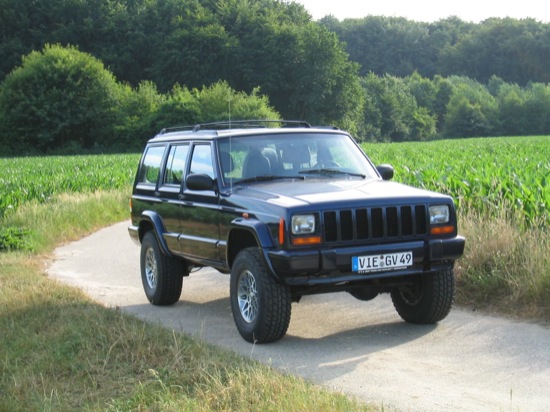
 king post too. I've almost ran out of internet now
king post too. I've almost ran out of internet now